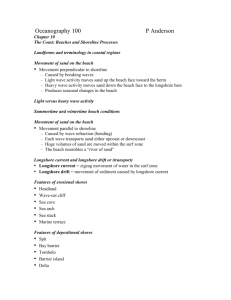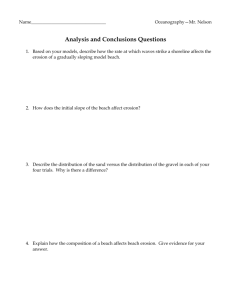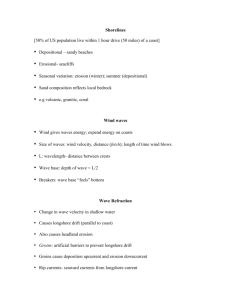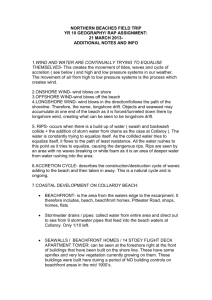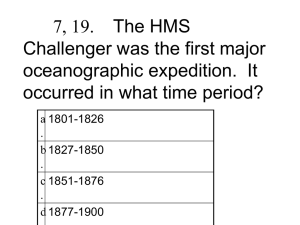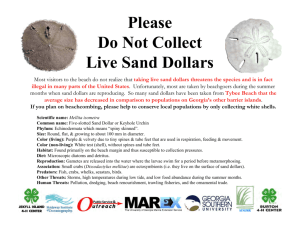Powerpoint
advertisement
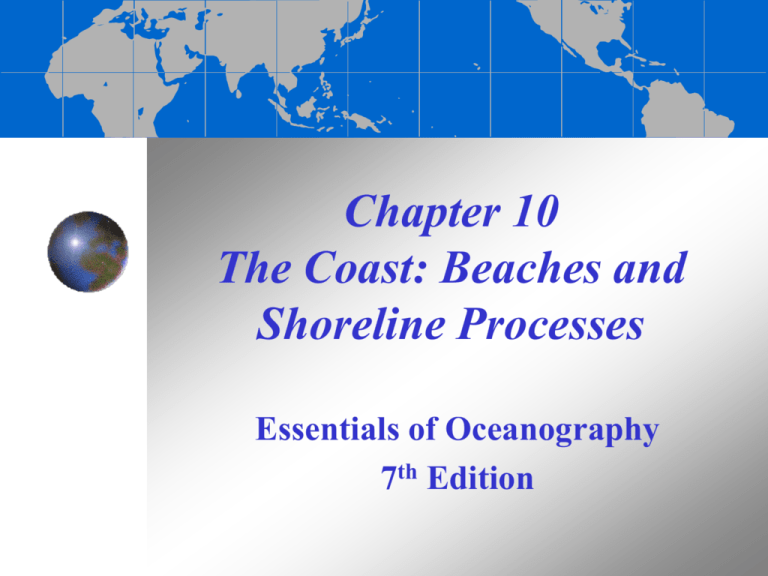
Chapter 10 The Coast: Beaches and Shoreline Processes Essentials of Oceanography 7th Edition Landforms and terminology in coastal regions Figure 10-1 Movement of sand on the beach Movement perpendicular (↕) to shoreline Caused by breaking waves Light wave activity moves sand up the beach face toward the berm Heavy wave activity moves sand down the beach face to the longshore bars Produces seasonal changes in the beach Light versus heavy wave activity Berm/longshore bar Light wave activity Heavy wave activity Berm grows and Longshore bars grow longshore bars shrink and berm shrinks Wave energy Low Time span Long Characteristics Summertime beach: sandy, wide berm, steep beach face High Short Wintertime beach: rocky, thin berm, flattened beach face Summertime and wintertime beach conditions Summertime beach Wintertime beach Figure 10-2 Movement of sand on the beach Movement parallel (↔) to shoreline Caused by wave refraction (bending) Each wave transports sand either upcoast or downcoast Huge volumes of sand are moved within the surf zone The beach resembles a “river of sand” Longshore current and longshore drift Longshore current = zigzag movement of water in the surf zone Longshore drift = movement of sediment caused by longshore current Figure 10-3b Features of erosional shores Headland Wave-cut cliff Sea cave Sea arch Sea stack Marine terrace Figure 10-4 Sea stack and sea arch, Oregon Features of depositional shores Spit Bay barrier Tombolo Barrier island Delta Figure 10-7 Barrier island, New Jersey Figure 10-9c Formation of barrier islands Sea level rose after the last Ice Age Caused barrier islands to roll toward shore like a tractor’s tread Figure 10-10 Beach compartments in southern California Beach compartments include: Rivers Beaches Submarine canyons Figure 10-12 Evidence of emerging and submerging shorelines Emergent features: Marine terraces Stranded beach deposits Submergent features: Drowned beaches Submerged dune topography Drowned river valleys Figure 10-13 Changes in sea level Sea level has changed throughout time Tectonic and isostatic movements are localized and change the level of the land Eustatic changes cause sea level to rise or fall worldwide and are produced by: Changes in seawater volume Changes in ocean basin capacity Sea level has risen since the last Ice Age Sea level was 120 meters (400 feet) lower during the last Ice Age About 18,000 years ago, sea level began to rise as the glacial ice melted Figure 10-14 Relative sea level rise at New York City Sea level has risen 40 centimeters (16 inches) since 1850 Global warming is predicted to increase the rate of sea level rise Figure 10-15 U.S. coastal erosion and deposition Figure 10-16 Types of hard stabilization Hard stabilization perpendicular to the coast within the surf zone: Jetties—protect harbor entrances Groins—designed to trap sand Hard stabilization parallel to the coast: Breakwaters—built beyond the surf zone Seawalls—built to armor the coast Jetties and Groins Jetties are always in pairs Groins can be singular or many (groin field) Both trap sand upstream and cause erosion downstream Figure 10-21 Breakwater at Santa Barbara Harbor, California Provides a boat anchorage Causes deposition in harbor and erosion downstream Sand must be dredged regularly Figure 10-22 Seawalls and beaches Seawalls are built to reduce erosion on beaches Seawalls can destroy recreational beaches Seawalls are costly and eventually fail Figure 10-24 Seawall damage in Leucadia, California Figure 10-25 Alternatives to hard stabilization Restrict the building of structures too close to the shore Eliminate programs that encourage construction in unsafe locations Relocate structures as erosion threatens them Relocation of the Cape Hatteras lighthouse, North Carolina Figure 10C End of Chapter 10 Essentials of Oceanography 7th Edition


